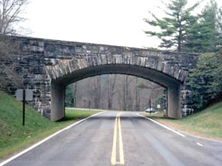 Blue Ridge Parkway (Wilkes County Bridge 69) over NC 16 south of Glendale Springs, built in 1937: entire reinforced concrete body of bridge, exposed only at underside of bridge, cast in place as a single unit (source: NCDOT bridge inspection files)
Blue Ridge Parkway (Wilkes County Bridge 69) over NC 16 south of Glendale Springs, built in 1937: entire reinforced concrete body of bridge, exposed only at underside of bridge, cast in place as a single unit (source: NCDOT bridge inspection files) The piers and deck of a reinforced concrete rigid frame bridge are interconnected with reinforcing steel and their concrete is poured as a unit. This differs from a typical reinforced concrete slab or tee beam bridge, where the deck is separate from and rests upon the piers.
The integration of the substructure and superstructure produces a strong, elastic bridge. The rigid frame is picturesque as well as practical. Its elliptical arches and potentially narrow profile have appealed to the proponents of highway beautification in the United States since the technology crossed the ocean from Europe in the 1920s.
Reinforced concrete rigid frame technology originated in Europe during the last part of the 19th century. Engineer Arthur G. Hayden first brought it to attention in America at the overpasses he designed in 1922-1923 for New York’s Bronx River Parkway. The bridge type requires expensive formwork to erect, but it is an effective use of material and it reduces the amount of in-ground work because the mass of the abutments is reduced.
The intrinsic form of the rigid frame is a shallow arch profile, typically well-proportioned, that lends itself well to settings where an aesthetically pleasing bridge is desired. It is frequently used in parks and on parkways, such as the Blue Ridge Parkway.
The North Carolina State Highway Department did not adopt the rigid frame as a standard design. Thus it was used infrequently and has not made a significant contribution to the overall development of the state highway system. A few individual examples of the type in the state are of architectural interest, however.
The King Street Overhead Bridge over the Southern Railway in Kings Mountain (Cleveland County Bridge 103), built in 1938, makes good use of the Art Moderne style. Vertically scored pilasters at the abutment corners continue upward into stepped posts for pipe railings with decorative bar fill. The railings flare over the gracefully curved and paneled wing walls, and the slab fascia are stepped outward.
It is one of only a few bridges designed by state bridge engineers from the late 1910s to 1950s that had custom (non-standardized) architectural details.